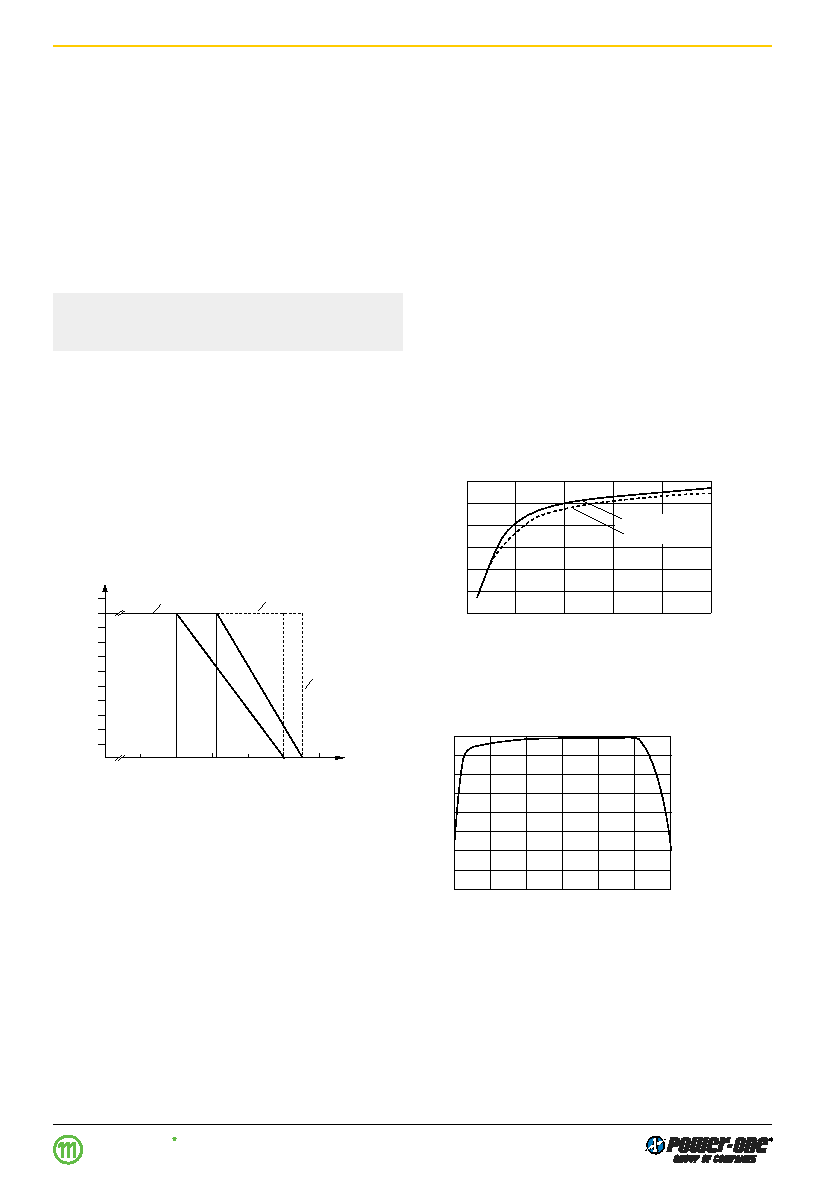- 您現(xiàn)在的位置:買賣IC網(wǎng) > PDF目錄44028 > LK5320-7ER (POWER-ONE INC) 2-OUTPUT 150 W AC-DC PWR FACTOR CORR MODULE PDF資料下載
參數(shù)資料
| 型號(hào): | LK5320-7ER |
| 廠商: | POWER-ONE INC |
| 元件分類: | 電源模塊 |
| 英文描述: | 2-OUTPUT 150 W AC-DC PWR FACTOR CORR MODULE |
| 封裝: | HEAT SINK, METAL, CASE K02 |
| 文件頁(yè)數(shù): | 2/28頁(yè) |
| 文件大?。?/td> | 1215K |
| 代理商: | LK5320-7ER |
第1頁(yè)當(dāng)前第2頁(yè)第3頁(yè)第4頁(yè)第5頁(yè)第6頁(yè)第7頁(yè)第8頁(yè)第9頁(yè)第10頁(yè)第11頁(yè)第12頁(yè)第13頁(yè)第14頁(yè)第15頁(yè)第16頁(yè)第17頁(yè)第18頁(yè)第19頁(yè)第20頁(yè)第21頁(yè)第22頁(yè)第23頁(yè)第24頁(yè)第25頁(yè)第26頁(yè)第27頁(yè)第28頁(yè)

K Series
AC-DC Converters >100 Watt
Rugged Environment
Edition 4/4.99
10/28
MELCHER
The Power Partners.
Thermal Protection
A temperature sensor generates an internal inhibit signal
which disables the outputs if the case temperature exceeds
TC max. The outputs are automatically re-enabled if the tem-
perature drops below this limit.
Output Protection
Each output is protected against overvoltage which could
occur due to a failure of the control circuit by means of a
voltage suppressor diode which, under worst case condi-
tions, may become a short circuit. The suppressor diodes
are not designed to withstand externally applied over-
voltages. Overload at any of the two outputs will cause a
shut-down of both outputs. A red LED indicates the over-
load condition.
Thermal Considerations
If a converter is located in free, quasi-stationary air (con-
vection cooling) at the indicated maximum ambient tem-
perature
TA max (see table: Temperature specifications) and
is operated at its nominal input voltage and output power,
the temperature measured at the
Measuring point of case
temperature TC (see: Mechanical Data) will approach the
indicated value
TC max after the warm-up phase. However,
the relationship between
TA and TC depends heavily on the
conditions of operation and integration into a system. The
thermal conditions are influenced by input voltage, output
current, airflow and temperature of surrounding compo-
nents and surfaces.
TA max is therefore, contrary to TC max,
an indicative value only.
Caution: The installer must ensure that under all operat-
ing conditions
TC remains within the limits stated in the
table:
Temperature specifications.
Notes: Sufficient forced cooling or an additional heat sink
allows
TA to be higher than 71
°C (e.g. 85°C) if T
C max is not
exceeded.
For -7 or -9 units at an ambient temperature
TA of 85
°C with
only convection cooling, the maximum permissible current
for each output is approx. 40% of its nominal value as per
figure.
It is recommended that continuous operation under simulta-
neous extreme worst case conditions of the following three
parameters be avoided: Minimum input voltage, maximum
output power and maximum temperature.
-6 versions have reduced
TA and TC
0
0.1
0.2
0.3
0.4
0.5
0.6
0.7
0.8
TA min 50
60
70
80
90
100
Io/Io nom
TA [°C]
0.9
1.00
forced cooling
convection cooling
TC max
-6 -7
-6
-7
05139
Fig. 8
Output current derating versus temperature for –7 and –9
units.
Efciency versus Load
0.2
0.4
0.6
0.8
1
0
0.90
0.30
0.40
0.50
0.60
0.70
0.80
Efficiency
Io/Io nom
Ui = 230 V AC
Ui = 85 V AC
05007
Fig. 9
Efciency versus load at Ui; 230 V AC and 88 V AC
Switching Frequency versus Load
0.2
0.4
0.6
0.8
1
0
60
0
10
20
30
40
50
Frequency [kHz]
load [Io/Io nom]
70
80
1.2
05008
Fig. 10
Switching frequency versus load. (The boost converter at
the input stage has a xed frequency of 100 kHz)
Parallel or Series Connection of Units
Single or double output units with equal nominal output volt-
age can be connected in parallel without any precautions
using option T.
With option T (current sharing), all units share the current
approximately equally.
Single output units and/or main and second outputs of dou-
ble output units can be connected in series with any other
(similar) output.
Note:
– Parallel connection of double output units should always
include both, main and second output to maintain good
regulation of both outputs.
– Not more than 5 units should be connected in parallel.
– Series connection of second outputs without involving
their main outputs should be avoided as regulation may
be poor.
– The maximum output current is limited by the output with
the lowest current limitation if several outputs are con-
nected in series.
相關(guān)PDF資料 |
PDF描述 |
|---|---|
| LK5320-7RD3 | 2-OUTPUT 150 W AC-DC PWR FACTOR CORR MODULE |
| LK5320-7RD4B1 | 2-OUTPUT 150 W AC-DC PWR FACTOR CORR MODULE |
| LK5320-9D9TB1 | 2-OUTPUT 150 W AC-DC PWR FACTOR CORR MODULE |
| LK5320-9PD1B2 | 2-OUTPUT 150 W AC-DC PWR FACTOR CORR MODULE |
| LK5320-9PD5T | 2-OUTPUT 150 W AC-DC PWR FACTOR CORR MODULE |
相關(guān)代理商/技術(shù)參數(shù) |
參數(shù)描述 |
|---|---|
| LK5320-7R | 功能描述:線性和開關(guān)式電源 Euro-Cassette 144W (2x 12V) RoHS:否 制造商:TDK-Lambda 產(chǎn)品:Switching Supplies 開放式框架/封閉式:Enclosed 輸出功率額定值:800 W 輸入電壓:85 VAC to 265 VAC 輸出端數(shù)量:1 輸出電壓(通道 1):20 V 輸出電流(通道 1):40 A 商用/醫(yī)用: 輸出電壓(通道 2): 輸出電流(通道 2): 安裝風(fēng)格:Rack 長(zhǎng)度: 寬度: 高度: |
| LK5320-9ER | 制造商:Power-One 功能描述:AC/DC PS DUAL-OUT 12V/12V 6A/6A 280W 15PIN - Bulk |
| LK-54H-SS18(LF)(SN) | 制造商:JST Manufacturing 功能描述: |
| LK5540-7R | 功能描述:線性和開關(guān)式電源 150W 15V 5A OUT AC-DC CONVERTER RoHS:否 制造商:TDK-Lambda 產(chǎn)品:Switching Supplies 開放式框架/封閉式:Enclosed 輸出功率額定值:800 W 輸入電壓:85 VAC to 265 VAC 輸出端數(shù)量:1 輸出電壓(通道 1):20 V 輸出電流(通道 1):40 A 商用/醫(yī)用: 輸出電壓(通道 2): 輸出電流(通道 2): 安裝風(fēng)格:Rack 長(zhǎng)度: 寬度: 高度: |
| LK5540-9ER | 制造商:Power-One 功能描述:ACDC - Bulk |
發(fā)布緊急采購(gòu),3分鐘左右您將得到回復(fù)。